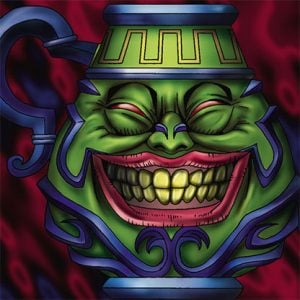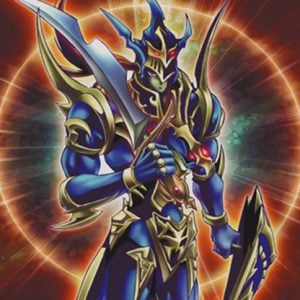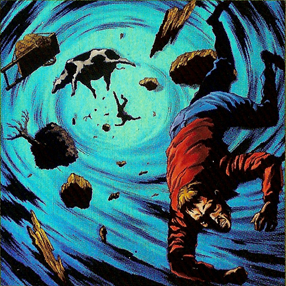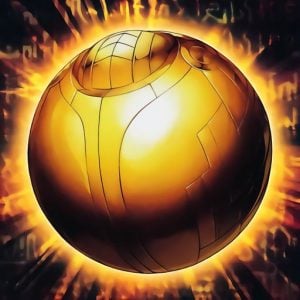“Who’s the Beatdown?” is about how similar decks should be played against each other. For example, sometimes a control deck must aggressively push against another control deck. Or an aggressive deck has to sacrifice damage to control the field. To determine this, we must find what our win condition is in every current situation. This is constantly changing, as it is related to available resources: Life Points, card advantage, and tempo.
Fundamental Resources
In card games, players dance around the other attempting to squander the opponent’s resources, or obtain lethal damage as quickly as possible. This can be divided into three basic parts, where one resource can be exchanged for the other. This is how we should determine the correct play; analyze the state of the game, find out which resource is most important, and make the play that maximizes it.
Life Points

In Yu-Gi-Oh!, there tends to be a sentiment that it “doesn’t matter how many Life Points you have, unless it’s zero.” This does highlight the mediocrity of plays that arbitrarily serve to protect a non-significant amount of life points. However, that is not at all to say that the Life Point count is non-important in formats like Goat Control. There are certain thresholds that should be established in Goat Format. There are many “burst” options that can end the game on a dime and should be considered when letting an attack go through. For example:
Black Luster Soldier – Envoy of the Beginning - 3000
Airknight Parshath – 1900
Tribe-Infecting Virus – 1600
Exarion Universe – 1400
Snatch Steal, Call of the Haunted – Variable
Knowing your format’s burst options are vital in knowing how far to extend your board. The first step to identify whether you’re the aggressor, or the “beatdown,” is identifying if it’s even possible to get your opponent into burst range. If there isn’t, then there’s no point in being the aggressor. Alternatively, if it is possible, then the question as to whether the investment to be the aggressor is better than trying to grind it out.
Card Advantage

The most simplistic of resources, card advantage refers to the amount of playable cards you have access to. Having useless cards (i.e. Mystical Space Typhoon while the opponent has no targets) don’t necessarily count in its consideration. This is the main indication on whether you should be the aggressor or defender. In a match where the opponent has access to more resources, you usually can’t outgrind them. This doesn’t necessarily mean you have to OTK the opponent – usually this isn’t possible – but it does mean that you should put more onto the board.
Tempo

Tempo is the amount of available options you can perform. Depending on its relationship to the other resources available, you may want to hold back on playing or setting a card. An example of acting on tempo would be summoning BLS – Envoy for damage.
Risk / Reward

Determining who’s the beatdown is essentially a risk / reward analysis. What do you have to lose if you set all your traps, and they are blown away by Heavy Storm? Can you risk summoning Black Luster Soldier – Envoy of the Beginning if you don’t have lethal? Will you survive if your opponent Snatch Steal’s it? Will you have enough tempo to recover if you don’t summon it? Misidentifying the attack will most certainly result in a loss in a format where duels last for 10+ turns. Let’s look at an example.
Who's the Beatdown? Duelistgroundz Goat Format War League Finals
Jazz v. Kris Perovic
Turn 2
Kris Perovic has a lone Exarion Universe with an attack reduction of 400 on board.
Jazz has Scapegoat and Dust Tornado set, with Sinister Serpent, Blade Knight and Heavy Storm in hand. Kris knows he has Sinister Serpent since it was searched with Sangan.
Jazz starts his turn by drawing Ring of Destruction.
He sets Ring of Destruction and Heavy Storm. He sumnons Blade Knight, attacking over Exarion Universe and ends his turn.
Kris summons Tsukuyomi, flipping Blade Knight face-down. Kris attacks Blade Knight with Tsukuyomi, and Jazz activates Ring of Destruction, destroying the attacking Tsukuyomi.
Kris then summon BLS - Envoy of the Beginning, banishing the face-down Blade Knight.
In this scenario, Jazz was the beatdown (the aggressor). How can we tell? Let's go play by play.
- Jazz runs over Exarion Universe with Blade Knight. That's an obvious play, but then he sets Heavy Storm along with Ring of Destruction. His set of Heavy Storm was two-fold: since he was committing to losing to an opposing Heavy Storm, setting it no longer mattered. But more importantly, Jazz recognized that he was the beatdown, so he needed as much protection for Blade Knight as possible. Heavy Storm makes the chance of a blind Mystical Space Typhoon or Breaker the Magical Warrior succeeding less possible.
This is all to protect Blade Knight. Jazz is the beatdown because he doesn't have enough resources to grind out the match. While it is rudimentary at best, Jazz's best bet of winning outside of topdecking is putting Kris on a five-turn clock. - Kris understands that Blade Knight is Jazz's win condition. If Kris can remove Blade Knight, then the match will almost certainly go in his favor as the control player in this scenario. He goes the safe route and flips Blade Knight with Tsukuyomi and attacks. Once that doesn't work, Kris will even use a high-power card like BLS to get rid of it. It's worth it to set Jazz back a couple of turns.
Determining who's the beatdown and acting upon it can be the difference between squeaking by and losing by a landslide. These roles change constantly, so it's worth it to ask who it is every turn.
Is This Relevant in Modern Yu-Gi-Oh?

Definitely! While it is much less traditionally resource-heavy, modern Yu-Gi-Oh! still relies on fundamentals. Should you go all in with the threat of Evenly Matched or The Winged Dragon of Ra - Sphere Mode? Should you do a combo that does 7800 damage but leaves you defenseless? The questions to ask yourself constantly are relevant to every card game.




